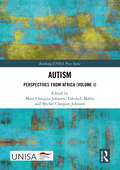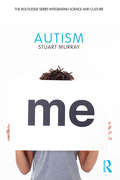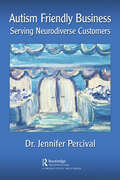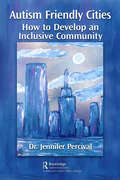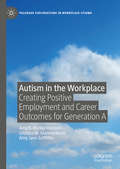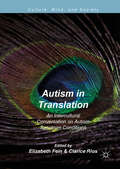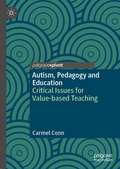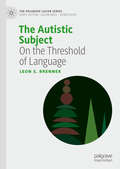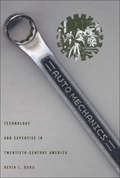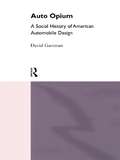- Table View
- List View
Autism: Perspectives from Africa (Volume I) (Routledge/UNISA Press Series)
by Mary Clasquin-Johnson Dikeledi Mahlo Michel Clasquin-JohnsonThis book is written at a time of a paradigm shift in the African continent where dependence on western epistemologies and ontologies are giving way to African indigenous knowledge systems. Africa has been an importer of knowledge from the west since time immemorial and this book contributes to the body of knowledge on autism spectrum disorder (ASD) from the African perspective. As a result, decoloniality and Inclusive Education have gained traction within the academic discourse, with University of South Africa (UNISA) hosting decoloniality annual conference and a summer school to stimulate academic discussions and debates with a focus on African indigenous knowledge systems and theoretical lenses as opposed to the western epistemologies. The book also demystifies some of the misconceptions that children with ASD are a curse and punishment from God or gods. Among others, Ubuntu seems to be the dominant theoretical framework underpinning some of the research studies reported in this book.
Autism
by Stuart MurrayAutism is the first book on the condition that seeks to combine medical, historical and cultural approaches to an understanding of the condition. Its purpose is to present a rounded portrayal of the ways in which autism is currently represented in the world, It focuses on three broad areas: the facts of scientific research, including new ideas surrounding research into genetics and neuroscience, as well as the details of diagnosis and therapy; the history of the condition as it developed through psychiatric approaches to the rise of parent associations, neurodiversity and autism advocacy; and the fictional and media narratives through which it is increasingly expressed in the contemporary moment. Accessible and written in clear English, Autism is designed for student audiences in English, Disability Studies, Cultural Studies, History, Sociology, and Medicine and Health, as well as medical practitioners and the general reader. Autism is a condition surrounded by misunderstanding and often defined by contestation and argument. The purpose of this book is to bring clarity to the subject of autism across the full range of its manifestations.
Autism: Culture, Narrative, Fascination (Representations: Health, Disability, Culture And Society Ser.)
by Stuart MurrayAutism is the first book on the condition that seeks to combine medical, historical and cultural approaches to an understanding of the condition. Its purpose is to present a rounded portrayal of the ways in which autism is currently represented in the world, It focuses on three broad areas: the facts of scientific research, including new ideas surrounding research into genetics and neuroscience, as well as the details of diagnosis and therapy; the history of the condition as it developed through psychiatric approaches to the rise of parent associations, neurodiversity and autism advocacy; and the fictional and media narratives through which it is increasingly expressed in the contemporary moment. Accessible and written in clear English, Autism is designed for student audiences in English, Disability Studies, Cultural Studies, History, Sociology, and Medicine and Health, as well as medical practitioners and the general reader. Autism is a condition surrounded by misunderstanding and often defined by contestation and argument. The purpose of this book is to bring clarity to the subject of autism across the full range of its manifestations.
Autism: A Social and Medical History
by M. WaltzThis book contextualizes autism as a socio cultural phenomenon, and examines the often troubling effects of representations and social trends. Exploring the individuals and events in the history of this condition, Waltz blends research and personal perspectives to examine social narratives of normalcy, disability and difference.
Autism: A Social and Medical History
by Mitzi WaltzThis expanded second edition of Mitzi Waltz’s Autism: A Social and Medical History offers an in-depth examination of how the condition was perceived before it became a separate area of investigation, and how autism has been conceptualised and treated since. As well as strengthening the existing text, Waltz has added material on a number of topics that have received increased attention since the first edition, including the rise of the anti-vaccination movement, the shift towards genetic and genomic research, and the progress of the autism self-advocacy movement. The author examines these issues through the perspective of what they mean for autistic people, clinicians and society, and looks at the challenges still faced by autistic people. Waltz also looks at the increased autism diagnosis among girls and women, and how autism has been represented in traditional media and social media. The book includes information from interviews with key researchers, parents of autistic children and people with autism.
Autism and the Family in Urban India: Looking Back, Looking Forward
by Shubhangi VaidyaThe book explores the lived reality of parenting and caring for children with autism in contemporary urban India. It is based on a qualitative, ethnographic study of families of children with autism as they negotiate the tricky terrain of identifying their child s disability, obtaining a diagnosis, accessing appropriate services and their on-going efforts to come to terms with and make sense of their child s unique subjectivity and mode of being. It examines the gendered dimensions of coping and care-giving and the differential responses of mothers and fathers, siblings and grandparents and the extended family network to this complex and often extremely challenging condition. The book tackles head on the sombre question, What will happen to the child after the parents are gone ? It also critically examines the role of the state, civil society and legal and institutional frameworks in place in India and undertakes a case study of Action for Autism ; a Delhi-based NGO set up by parents of children with autism. This book also draws upon the author s own engagement with her child’ s disability and thus lends an authenticity born out of lived experience and in-depth understanding. It is a valuable addition to the literature in the sociology of the family and disability studies.
Autism Equality in the Workplace: Removing Barriers and Challenging Discrimination (PDF)
by Janine Booth John McdonnellNeurodiversity in the workplace can be a gift. Yet only 15% of adults with an autism spectrum condition (ASC) are in full-time employment. This book examines how the working environment can embrace autistic people in a positive way. The author highlights common challenges in the workplace for people with ASC, such as discrimination and lack of communication or the right kind of support from managers and colleagues, and provides strategies for changing them. Setting out practical, reasonable adjustments such as a quiet room or avoiding disruption to work schedules, this book demonstrates how day to day changes in the workplace can make it more inclusive and productive for all employees. Autism in the Workplace is intended for any person with an interest in changing working culture to ensure equality for autistic people. It is an essential resource for employers, managers, trade unionists, people with ASCs and their workmates and supporters.
Autism Equality in the Workplace: Removing Barriers and Challenging Discrimination
by John Mcdonnell Janine BoothNeurodiversity in the workplace can be a gift. Yet only 15% of adults with an autism spectrum condition (ASC) are in full-time employment. This book examines how the working environment can embrace autistic people in a positive way. The author highlights common challenges in the workplace for people with ASC, such as discrimination and lack of communication or the right kind of support from managers and colleagues, and provides strategies for changing them. Setting out practical, reasonable adjustments such as a quiet room or avoiding disruption to work schedules, this book demonstrates how day to day changes in the workplace can make it more inclusive and productive for all employees. Autism in the Workplace is intended for any person with an interest in changing working culture to ensure equality for autistic people. It is an essential resource for employers, managers, trade unionists, people with ASCs and their workmates and supporters.
Autism Friendly Business: Neurodiverse Customers (Autism Friendly)
by Jennifer PercivalDesigned as a guidebook for leaders at the beginning of their journey embracing neuroinclusion, Autism Friendly Business: Neurodiverse Customers will provide business owners, executives, managers, team members, and associates the tools to integrate strategies and techniques that will enhance their business, while improving the delivery of a quality experience for all. Autistic individuals often experience barriers when engaging with businesses. This book provides solutions and examples on how leaders can remove obstacles to develop supportive and inclusive environments.
Autism Friendly Business: Neurodiverse Customers (Autism Friendly)
by Jennifer PercivalDesigned as a guidebook for leaders at the beginning of their journey embracing neuroinclusion, Autism Friendly Business: Neurodiverse Customers will provide business owners, executives, managers, team members, and associates the tools to integrate strategies and techniques that will enhance their business, while improving the delivery of a quality experience for all. Autistic individuals often experience barriers when engaging with businesses. This book provides solutions and examples on how leaders can remove obstacles to develop supportive and inclusive environments.
Autism Friendly Cities: How to Develop an Inclusive Community
by Jennifer PercivalAccess. Inclusion. Diversity. All people deserve to be embraced by their community. Autism Friendly Cities: How to Create an Inclusive Community is the first book designed to guide city leadership and staff through the process of evaluation, training, implementation, and developing an Autism Friendly initiative that will help you open your doors to everyone. People with autism should be able to participate in all that is offered and facilitated by their city, including services, activities, events, and points of connection. Being an Autism Friendly City is not only socially responsible, but will improve engagement, outreach, economic development, and resident satisfaction.
Autism Friendly Cities: How to Develop an Inclusive Community
by Jennifer PercivalAccess. Inclusion. Diversity. All people deserve to be embraced by their community. Autism Friendly Cities: How to Create an Inclusive Community is the first book designed to guide city leadership and staff through the process of evaluation, training, implementation, and developing an Autism Friendly initiative that will help you open your doors to everyone. People with autism should be able to participate in all that is offered and facilitated by their city, including services, activities, events, and points of connection. Being an Autism Friendly City is not only socially responsible, but will improve engagement, outreach, economic development, and resident satisfaction.
Autism in the Workplace: Creating Positive Employment and Career Outcomes for Generation A (Palgrave Explorations in Workplace Stigma)
by Amy E. Hurley-Hanson Cristina M. Giannantonio Amy Jane GriffithsThis book explores the career experiences of Generation A, the half-million individuals with autism spectrum disorder (ASD) who will reach adulthood in the next decade. With Generation A eligible to enter the workforce in unprecedented numbers, research is needed to help individuals, organizations, and educational institutions to work together to create successful work experiences and career outcomes for individuals with ASD. Issues surrounding ASD in the workplace are discussed from individual, organizational, and societal perspectives. This book also examines the stigma of autism and how it may affect the employment and career experiences of individuals with ASD. This timely book provides researchers, practitioners, and employers with empirical data that examines the work and career experiences of individuals with ASD. It offers a framework for organizations committed to hiring individuals with ASD and enhancing their work experiences and career outcomes now and in the future.
Autism in Translation: An Intercultural Conversation on Autism Spectrum Conditions (Culture, Mind, and Society)
by Elizabeth Fein Clarice RiosAutism is a complex phenomenon that is both individual and social. Showing both robust similarities and intriguing differences across cultural contexts, the autism spectrum raises innumerable questions about self, subjectivity, and society in a globalized world. Yet it is often misrepresented as a problem of broken bodies and disordered brains. So, in 2015, a group of interdisciplinary scholars gathered in Rio de Janeiro, Brazil for an intellectual experiment: a workshop that joined approaches from psychological anthropology to the South American tradition of Collective Health in order to consider autism within social, historical, and political settings. This book is the product of the ongoing conversation emerging from this event. It contains a series of comparative histories of autism policy in Italy, Brazil, and the United States; focuses on issues of voice, narrative, and representation in autism; and examines how the concept of autism shapes both individual lives and broader social and economic systems. Featuring contributions from:Michael BakanBenilton BezerraPamela BlockM. Ariel Cascio Jurandir Freire CostaBárbara Costa AndradaCassandra EvansElizabeth Fein Clara Feldman Roy Richard GrinkerRossano LimaFrancisco OrtegaDawn Prince-HughesClarice Rios Laura Sterponi Thomas S. WeisnerEnrico Valtellina
Autism in Translation: An Intercultural Conversation on Autism Spectrum Conditions (Culture, Mind, and Society)
by Elizabeth Fein Clarice RiosAutism is a complex phenomenon that is both individual and social. Showing both robust similarities and intriguing differences across cultural contexts, the autism spectrum raises innumerable questions about self, subjectivity, and society in a globalized world. Yet it is often misrepresented as a problem of broken bodies and disordered brains. So, in 2015, a group of interdisciplinary scholars gathered in Rio de Janeiro, Brazil for an intellectual experiment: a workshop that joined approaches from psychological anthropology to the South American tradition of Collective Health in order to consider autism within social, historical, and political settings. This book is the product of the ongoing conversation emerging from this event. It contains a series of comparative histories of autism policy in Italy, Brazil, and the United States; focuses on issues of voice, narrative, and representation in autism; and examines how the concept of autism shapes both individual lives and broader social and economic systems. Featuring contributions from:Michael BakanBenilton BezerraPamela BlockM. Ariel Cascio Jurandir Freire CostaBárbara Costa AndradaCassandra EvansElizabeth Fein Clara Feldman Roy Richard GrinkerRossano LimaFrancisco OrtegaDawn Prince-HughesClarice Rios Laura Sterponi Thomas S. WeisnerEnrico Valtellina
The Autism Matrix
by Gil EyalToday autism has become highly visible. Once you begin to look for it, you realize it is everywhere. Why? We all know the answer or think we do: there is an autism epidemic. And if it is an epidemic, then we know what must be done: lots of money must be thrown at it, detection centers must be established and explanations sought, so that the number of new cases can be brought down and the epidemic brought under control. But can it really be so simple? This major new book offers a very different interpretation. The authors argue that the recent rise in autism should be understood an “aftershock” of the real earthquake, which was the deinstitutionalization of mental retardation in the mid-1970s. This entailed a radical transformation not only of the institutional matrix for dealing with developmental disorders of childhood, but also of the cultural lens through which we view them. It opened up a space for viewing and treating childhood disorders as neither mental illness nor mental retardation, neither curable nor incurable, but somewhere in-between. The authors show that where deinstitutionalization went the furthest, as in Scandinavia, UK and the “blue” states of the US, autism rates are also highest. Where it was absent or delayed, as in France, autism rates are low. Combining a historical narrative with international comparison, The Autism Matrix offers a fresh and powerful analysis of a condition that affects many parents and children today.
The Autism Matrix
by Gil EyalToday autism has become highly visible. Once you begin to look for it, you realize it is everywhere. Why? We all know the answer or think we do: there is an autism epidemic. And if it is an epidemic, then we know what must be done: lots of money must be thrown at it, detection centers must be established and explanations sought, so that the number of new cases can be brought down and the epidemic brought under control. But can it really be so simple? This major new book offers a very different interpretation. The authors argue that the recent rise in autism should be understood an “aftershock” of the real earthquake, which was the deinstitutionalization of mental retardation in the mid-1970s. This entailed a radical transformation not only of the institutional matrix for dealing with developmental disorders of childhood, but also of the cultural lens through which we view them. It opened up a space for viewing and treating childhood disorders as neither mental illness nor mental retardation, neither curable nor incurable, but somewhere in-between. The authors show that where deinstitutionalization went the furthest, as in Scandinavia, UK and the “blue” states of the US, autism rates are also highest. Where it was absent or delayed, as in France, autism rates are low. Combining a historical narrative with international comparison, The Autism Matrix offers a fresh and powerful analysis of a condition that affects many parents and children today.
Autism, Pedagogy and Education: Critical Issues for Value-based Teaching
by Carmel ConnThis book discusses critical issues concerning autism and education, and what constitutes effective pedagogy for this group of learners. Autism is a high-profile area within the discipline of special education, and the issue of how to teach autistic learners remains a contested one: recent theorising has questioned a techno-rationalist approach that places the burden of change on the autistic pupil. The author explores the values that underpin educational approaches within existing pedagogical practice: while these approaches have their individual merits and shortcomings, this book introduces and expands upon a strengths-based approach. This book will appeal to students and scholars of autism and education, with particular regard to teaching autistic learners.
The Autistic Subject: On the Threshold of Language (The Palgrave Lacan Series)
by Leon S. BrennerThis book presents a theory of autistic subjectivity from a Lacanian psychoanalytic perspective. Dr. Brenner describes autism as a singular mode of being that is fundamentally linked to one’s identity and basic practices of existence, offering a rigorous alternative to treating autism as a mental or physical disorder. Drawing on Freud and Lacan’s psychoanalytic understanding of the subject, Brenner outlines the unique features of the autistic subjective structure and provides a comprehensive synthesis of contemporary work on the psychoanalysis of autism. The book examines research by theorists including Jean-Claude Maleval, Éric Laurent, Rosine and Robert Lefort that has been largely unavailable to Anglophone audiences until now. In this book autism is posited to be a singular subjective structure not reducible to neurosis or psychosis. In accordance with the Lacanian approach, autism is examined with detailed attention to the subject’s use of language, culminating in Brenner’s “autistic linguistic spectrum.” A compelling read for students and scholars of psychoanalysis and autism researchers and clinicians.
An Auto/Biographical Approach to Learning Disability Research (Routledge Revivals)
by Dorothy AtkinsonFirst published in 1997 , Dorothy Atkinson collects testimonies of the personal perspectives of people with learning disability in order to rediscover the histories of people with learning disabilities. Calling on the importance if auto/biographical research as mode to encourage social, historical awareness and potential understanding of the commonalities as well the differences between people with learning difficulties.
An Auto/Biographical Approach to Learning Disability Research (Routledge Revivals)
by Dorothy AtkinsonFirst published in 1997 , Dorothy Atkinson collects testimonies of the personal perspectives of people with learning disability in order to rediscover the histories of people with learning disabilities. Calling on the importance if auto/biographical research as mode to encourage social, historical awareness and potential understanding of the commonalities as well the differences between people with learning difficulties.
Auto-Industrialism: DIY Capitalism and the Rise of the Auto-Industrial Society
by Peter MurphyDIY check-outs, drones, self-driving cars, and e-government: all are signs of the coming auto-industrial age. Will this end in mass unemployment or will new kinds of work emerge? Will 3D print production, desktop workshops and mass customization make up for lost blue-collar jobs? What will happen to health and education in the auto-industrial age? Will machines replace teachers and doctors? What might the economic and social future dominated by self-employment and a large DIY industry look like? Peter Murphy's lively, provocative book addresses these questions head-on.
Auto-Industrialism: DIY Capitalism and the Rise of the Auto-Industrial Society (PDF)
by Peter MurphyDIY check-outs, drones, self-driving cars, and e-government: all are signs of the coming auto-industrial age. Will this end in mass unemployment or will new kinds of work emerge? Will 3D print production, desktop workshops and mass customization make up for lost blue-collar jobs? What will happen to health and education in the auto-industrial age? Will machines replace teachers and doctors? What might the economic and social future dominated by self-employment and a large DIY industry look like? Peter Murphy's lively, provocative book addresses these questions head-on.
Auto Mechanics: Technology and Expertise in Twentieth-Century America (Studies in Industry and Society)
by Kevin L. BorgThe history of automobiles is not just the story of invention, manufacturing, and marketing; it is also a story of repair. Auto Mechanics opens the repair shop to historical study—for the first time—by tracing the emergence of a dirty, difficult, and important profession.Kevin L. Borg's study spans a century of automotive technology—from the horseless carriage of the late nineteenth century to the "check engine" light of the late twentieth. Drawing from a diverse body of source material, Borg explores how the mechanic’s occupation formed and evolved within the context of broad American fault lines of class, race, and gender and how vocational education entwined these tensions around the mechanic’s unique expertise. He further shows how aspects of the consumer rights and environmental movements, as well as the design of automotive electronics, reflected and challenged the social identity and expertise of the mechanic.In the history of the American auto mechanic, Borg finds the origins of a persistent anxiety that even today accompanies the prospect of taking one's car in for repair.
Auto-Opium: A Social History of American Automobile Design
by David GartmanThis much needed book is the first to provide a comprehensive history of the profession and aesthetics of American automobile design. The author reveals how the appearance of the automobile was shaped by the social conflicts arising from America's mass production system. He connects the social struggles of American society with the organizational struggles of designers to create symbol-laden substitutes for the American dream. Theoretically sophisticated, lucid and compelling, Auto-Opium will appeal to all interested in the American obsession with the car.
